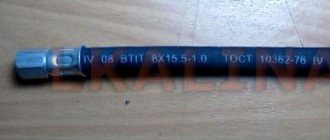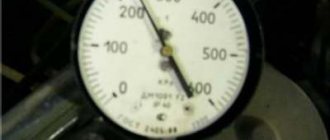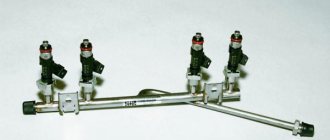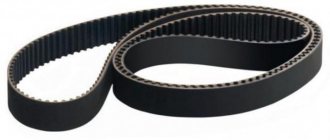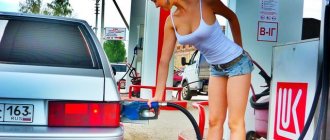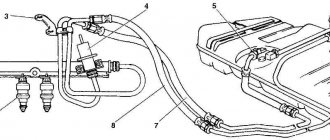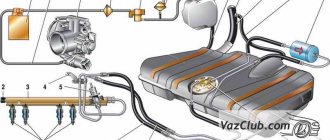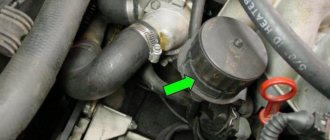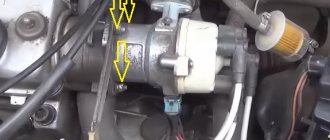Diagram of the power supply system for the VAZ 2109 injection engine
The power supply system for the injection engine 2111 of VAZ 21083i, 21093i, 21099i vehicles is designed to ensure uninterrupted supply of fuel to the engine cylinders. In addition, it has the functions of storing a certain supply of fuel on board the vehicle and cleaning it from mechanical contamination.
Engine power supply system diagram 2111
Diagram of the power supply system for the injection engine 2111 of VAZ 2108, 2109, 21099 cars (EURO-2 toxicity standards)
Elements of the power supply system for injection engines of VAZ 21083i, 21093i, 210993i cars
— The fuel tank is welded, welded from two stamped halves. Capacity 43 liters. The filler neck is located in the right rear fender of the car.
— The fuel module (electric fuel pump) is installed in the fuel tank and combines a fuel pump and a fuel level indicator sensor. To access the module, there is an inspection hatch under the rear seat in the car body. A fuel purification strainer is installed on the inlet pipe of the fuel module.
— fuel filter in a metal casing, not dismountable, is installed under the bottom of the car, next to the fuel tank.
— The fuel rail supplies fuel from the supply line to the four injectors inserted into it. The connection between the ramp and the injectors is sealed with rubber rings. At the end of the ramp there is a diagnostic fitting for measuring pressure in the system.
— An injector is an electromagnetic valve that allows fuel to flow into the cylinders when voltage is applied to it and closes when there is no power under the action of a return spring. At the end of the injector there is a nozzle through which fuel is injected into the intake manifold. The injection system controller controls the injectors.
— Fuel pressure regulator – bypass valve installed on the fuel rail. It maintains the required operating pressure in the fuel line (around 3 atmospheres). And it changes depending on the engine speed. Excess fuel is discharged back into the fuel tank via the return line.
— Separator – element of the fuel vapor recovery system (under EURO 2). Fixed under the rear right fender of the car. In it, gasoline vapors condense and return back to the fuel tank. Fuel vapors that have not had time to condense enter from the separator into the adsorber.
— Adsorber - a container (element of the fuel vapor recovery system), where fuel vapors coming from the separator are absorbed by activated carbon. When the engine crankshaft speed increases, the control unit gives a command to open the canister purge valve and gasoline vapors are sucked into the intake module receiver. Installed in the engine compartment.
— The gravity valve prevents fuel from leaking out of the fuel tank when the vehicle turns over.
— A two-way valve prevents excessive increase or vice versa decrease in pressure in the fuel tank.
Notes and additions
— Elements of the fuel vapor recovery system (separator, adsorber) are available only on VAZ 21083i, 21093i, 21099i vehicles that comply with EURO 2 standards.
Where is the temperature sensor located?
If the temperature sensor does not show on the instrument panel, there is a high risk of overheating the engine, since the instrument panel does not inform the driver about the heating of the internal combustion engine coolant. Of course, the instrument panel or electrical wiring may be faulty, but most often the temperature sensor (DTOZH) on the engine itself refuses to work.
Where is the temperature sensor located on an injection car 099? Of course, you need to look for it in the engine compartment:
- open the hood;
- we find the wiring that is located between the rear of the engine valve cover and the air filter housing;
- where the DTOZH is located can be seen in more detail in the following photos.
Fuel injection system
For the new injection engine, an injection tank with a submersible pump was needed; I didn’t even consider the option with a remote Volgov pump, because my carburetor gas tank was already pretty tattered.
This is an old-style connector, similar to the lambda probe connector.
Also, as a bonus, I removed the fuel filter mount and the already rotted fuel lines and their fastenings to the body. The fastenings of injection lines differ from carburetor ones by the presence of an additional cell for the return line, which on injection cars is thicker than on carburetor cars.
The outside of the tank was cleaned of chips and rusty places, primed, and the entire tank was painted with Pfka.
When removing the module, it was discovered that the contact track on the FLS had been erased,
I revived it by soldering wire onto the end of the float
At first, the fuel pressure regulator was planned to be made from the GAZ 406 RTD of a new type, which gives a pressure of 3.8 bar because in the 124 engine the injectors are designed for exactly this pressure. This RTD was purchased, a thread was cut into its hole and an 8mm fitting was screwed onto the epoxy.
When I removed the module, I figured out the pinout of the connector, bought a lambda connector from my dad, and assembled the entire system for the battery test.
During the test, it turned out that the pump does not pump more than 3.4bar, the pressure in the “wall” with the return compressed is 4.4bar,
This pump could still work at a pressure of 3bar, but for a pressure of 3.8bar it is clearly not enough.
New details:
- weber pump
- Gas tank sensor 2110 DUT-1-01
- Gasket for fuel pump 2110, 2111, 2112
- Mesh filter 2110
- Fuel filter
- Fuel filter (injector) Tavria
- Fuel pipes 2109 1.5 l
- O-ring for fuel hoses 2110, 2111, 2112 BOSCH 30pcs
- Gas tank pipe 2108 BRT
Upon arrival of the parts, I replaced the pump, blower, mesh and tank o-ring
The pressure test with the new pump was successfully passed, 3.8bar, and when the hose was pinched, the pressure gauge went off scale and went to the second round. I pressed about 8-9bar into the “wall”. The gas tank was ready for installation.
I bought a 120g set of fuel lines at the market in Kharkov on the same day I bought the engine, but upon arrival I found out that instead of a supply + return set, they sold me two feeds on one of which “RETURN” was written in marker. At a local store I order an injection return for a VAZ 2109, they promise to deliver it in a week, but in the end a carburetor one arrives. On the site where I usually get spare parts there is no return line either. I search in all possible online stores, and here the most interesting thing begins on most sites as a sample return photo submission, I call to clarify whether the item in the photo is for sale, it’s also a PPC submission, and so on in every store.
As a result, I found a store that had a photo of the return line as an example, I called to clarify in detail, they even sent the photo to Viber, I made sure that it was exactly what I needed, it was sold as an original DAAZ for 230 UAH + 30 UAH in-time delivery. Well, now the whole set is available. While he was waiting, I removed the exhaust and the old lines, all the nuts were unscrewed normally, not a single stud was torn off, as usually happens. I oiled the niche until nothing was in the way; the brake pipes were quietly hanging in the air.
I removed the steering rack and laid new lines. Since there were no studs on the body for fastening the fuel filter bracket, and no welding to weld them, I hung it through the holes in the spare tire niche.
Everyone is here.
The left gas tank bracket fit from the carburetor, but the right one had to be lengthened, I cut out a metal plate of the required length and bolted it on.
The gas tank pipe is very sad
Installed a new one
When the tank was screwed into place, I decided that it would be a good idea to cut a technological hole to remove the fuel pump module without removing the tank from the car, because this procedure is very labor-intensive.
In order not to cut too much, I marked the boundaries of the module, and in order not to damage anything, I removed only the installed tank. I’ll tell you how I cut the hole for the module in the next post.
What is an injector - a modern replacement for a carburetor
An injector is a device that replaces the operation of a carburetor and consists of a fuel rail (rail) onto which injectors are attached. Under high pressure from the gasoline pump, fuel enters the rack, and from there the gasoline is distributed to the injectors. The injector nozzles, using rubber sealing rings, are inserted together with the rack into the engine block and inject fuel, which later ignites.
One of the main parts of the work in the injector is done by the intake manifold. Its device includes a throttle valve, which is responsible for supplying air from the environment to the engine block.
The injector is a rather thin device, the operation of which is regulated in a constant mode by the electrical “brain” (the central part of the nervous system of animals, usually located in the head part of the body and representing a compact accumulation of nerve cells and their processes)
» punishment.
The presence of an on-board computer allows specialized car repair shops to quickly and accurately diagnose the vehicle. Diagnostics (the process of establishing a diagnosis, that is, a conclusion about the nature of the disease and the patient’s condition)
is carried out by connecting special equipment through a connector to the on-board computer of the car.
Injection models of the VAZ 21099 since 2000 also acquired electric “brains”. This car model has front-wheel drive, indicating the highest stability on the roads. The engine of the injection 99 is 4-cylinder, eight-valve, with a displacement of 1.5 liters. In a modern VAZ, the highest speed indicated on the speedometer is 180 km/h. In practice, it is not recommended to accelerate this car above 160 km/h.
The design feature of the car's injector is its much lower fuel consumption compared to a carburetor car. VAZ 21099 (injector) has an average consumption of 7.0–7.5 liters per 100 km, at an average speed of 100–120 km/h. It was possible to achieve a reduction in fuel consumption by reducing the energy consumption of the vehicle. It should be noted that the injector of this car is not very picky about octane fuel and consumes gasoline identically, both A-92 and A-95.
VAZ 2109 injector diagram: how it works
In 1997, they began producing 2109-20 cars, which are equipped with an engine with a distributed injection system (injector). This improves their efficiency, environmental and traction performance. Distributed injection is so called because fuel is injected directly into each cylinder by a separate injector.
Such a system makes it possible to somewhat reduce the toxicity of exhaust gases, as well as improve the driving performance of the 2109 car. Today, there are injection systems without feedback and with feedback. Both presented systems can include domestic and imported components. Each of the systems has its own design, repair and diagnostic features. I would just like to note the main principles of the design, normal operation, engine repair (if necessary) and subsequent diagnostics of the fuel injection system (the VAZ 2109 injector diagram is presented below).
The automotive fuel injection system, which has feedback, is used mainly on export VAZ 2109. The exhaust system of these cars is equipped with a catalytic converter for exhaust gases and an oxygen sensor. It provides feedback. Using an oxygen sensor, the oxygen concentration in already exhaust gases is monitored.
Next, the electronic control unit (ECU) of the vehicle, according to its signals, maintains the appropriate ratio of fuel and air, that is, one at which the special converter works extremely efficiently. The injection system, in which there is no feedback, is not equipped with a converter and an oxygen sensor.
Their function (regulating the concentration of CO in already completely exhausted gases) is performed by a CO potentiometer. They also do not use a gasoline vapor recovery system.
Content
The injector is controlled by electronic signals that come from the processor
, and he, in turn, in order to issue them, tracks signals from sensors installed on and in the engine.
The only work that can be done on an injection engine to adjust it and stabilize its operation is flushing the injector, or more precisely, flushing the injectors.
